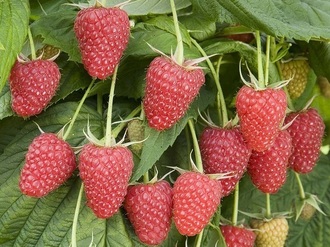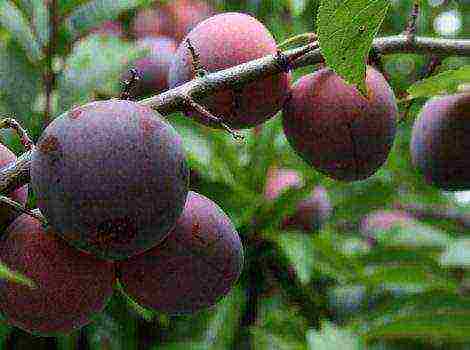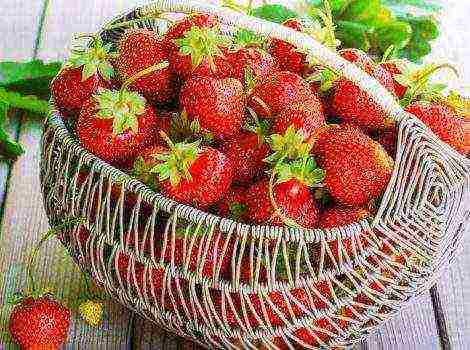Content
- 1 Requirements for grape varieties for the Samara region
- 2 Frost-resistant grape varieties (video)
- 3 The best varieties for the region
- 4 Landing terms and rules
- 5 Features of caring for grapes in the Samara region
- 6 Protection from pests and diseases
- 7 Shelter of grapes for the winter in the Samara region
- 8 How to plant grapes in spring (video)
- 9 Reviews and comments
- 10 Kinelsky grapes - the best varieties
- 11 The choice of planting material
- 12 When to plant?
- 13 Step-by-step instructions for planting Kinel grapes
- 14 Wasp control
- 15 Top dressing
- 16 Grape seedlings care
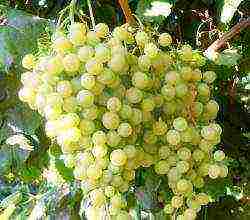 Grapes (Vitis) are a favorite crop of many gardeners. Its berries make excellent wine and raisins, or you can just eat them fresh. It's nice if the bunches are large, and the berries are filled with juice and not touched by pests. To achieve this, you need competent care, which is selected depending on the variety and growing region.
Grapes (Vitis) are a favorite crop of many gardeners. Its berries make excellent wine and raisins, or you can just eat them fresh. It's nice if the bunches are large, and the berries are filled with juice and not touched by pests. To achieve this, you need competent care, which is selected depending on the variety and growing region.
Requirements for grape varieties for the Samara region
Before planting grapes in the Samara region, you need to decide on a variety. Not all the varieties you like can grow and fully bear fruit in the specified region. It is important to take into account the frost resistance of the plant, its ripening time and disease resistance.
Frost resistance requirements
Frost-resistant grape varieties are successfully grown in the Samara region. In this case, the plants still require shelter for the winter. Among other things, the variety for planting should not only have good resistance to low temperatures, but also excellent resistance to drought.
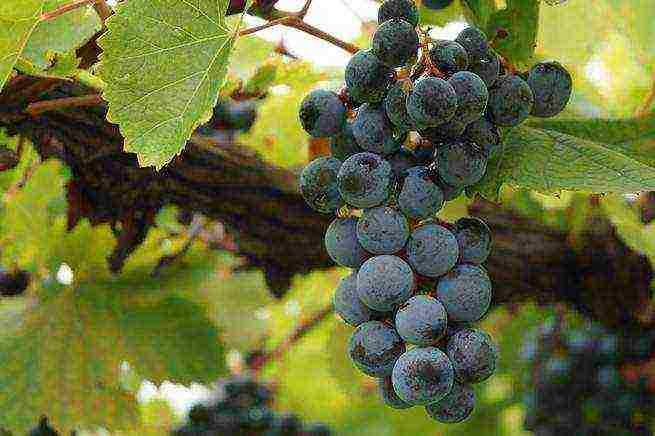
The question of the timing of ripening
To get a good harvest in the Samara region, it is better to choose early grape varieties. Since there is no lack of light in the region, and most days are clear, there should be no problems with plant cultivation. But in the second half of summer, daylight hours are shortened, so it is better to use early varieties so that they have time to ripen.
Disease resistance of the variety
In Samara, the climate is continental, and the air humidity is low. That is why the grapes grown here practically do not suffer from oidium and mildew. Pests affect varieties extremely rarely, phylloxera does not occur at all. This means that even those varietal varieties that cannot boast of high disease resistance can be grown in the specified region.
Also read: Presses for grapes: selection rules and self-production
Frost-resistant grape varieties (video)
The best varieties for the region
| Variety name | Peculiarities | Features of the fruit | Resistant to frost and disease |
| Radiant raisins (Latin uvampassamradiant) | Yielding variety, recommended for planting with other varieties |
Raspberry berries, large, no seeds |
Excellent stability |
| In memory of Negrul (memoria Negrul) | A promising variety with good keeping quality | The berries are beautiful, large, nipple-shaped | Good stability |
| Christina | The bunches hang until October | Berries are large, barrel-shaped, color red | Excellent disease resistance and winter hardiness |
| Tomaysky |
A productive variety, but does not tolerate overloading well, therefore it is required to carry out rationing of bunches |
Fruits are sweet, sugary, black |
Average resistance |
| Delight (Jucundum) | Produces a good harvest when planted with a pollinator | Sugary berries | High frost resistance - up to -25 degrees |
| Stable Bulgarian Cardinal | Old famous variety | Berries are dark purple, large, nutmeg | Average resistance |
| Laura | The variety is well-known, the berries have a honey flavor | The bunches and fruits are large | Average resistance |
| Elegy (Elegia) | Hybrid variety "Rusven" | Fleshy, tasty, nutmeg berries | High winter hardiness, requires fertile soil |
| Friendship (Amicitia) | The variety is characterized by fast growth |
The berries are delicious |
Average resistance |
| Codreanca-218 (Codreanca) | Bunches and berries are large | Berries are tart, black, large | Average resistance |
Landing dates and rules
After the variety is selected, you can start planting. It should be remembered here that grapes are a thermophilic culture, they are afraid of drafts and love a lot of sun. These factors need to be considered when choosing a location.
The soil must also meet certain requirements. Grapes grow well on sandy loam and do not tolerate stagnant water, so the groundwater level should not be closer than 2 m from the surface of the earth.
Grapes are planted in Samara in spring. The optimal time is mid-April-early May. At the same time, it is important that the soil and air are warmed up to + 10 degrees.
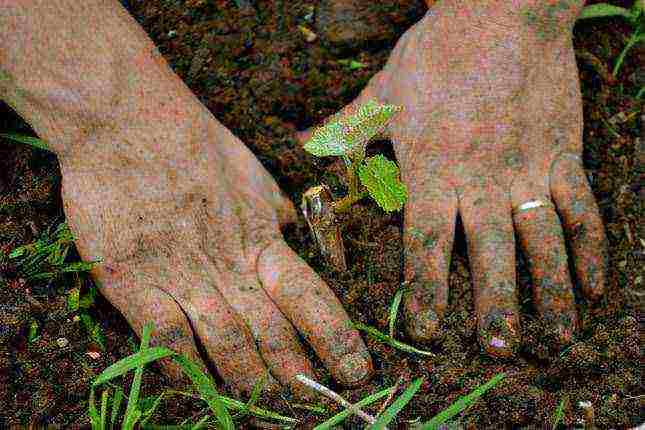
Features of caring for grapes in the Samara region
Grape care should be comprehensive and regular. Digging the soil in spring and autumn is carried out for normal oxygen circulation. You should also make a preventive examination of leaves and shoots for diseases and pests.
Three times during the growing season, spraying with special preparations is carried out to prevent various diseases.
Timing and features of pruning
The grapes require mandatory pruning in the fall. This is necessary so that the next year the harvest is of the highest quality. An uncircumcised vine leads to large ovary formation and strong chopping of the berries on the bunches. Experts advise cutting the vine into 6-8 eyes. If for some reason the pruning was not done in the fall, then in the spring it should be done before the buds bloom.
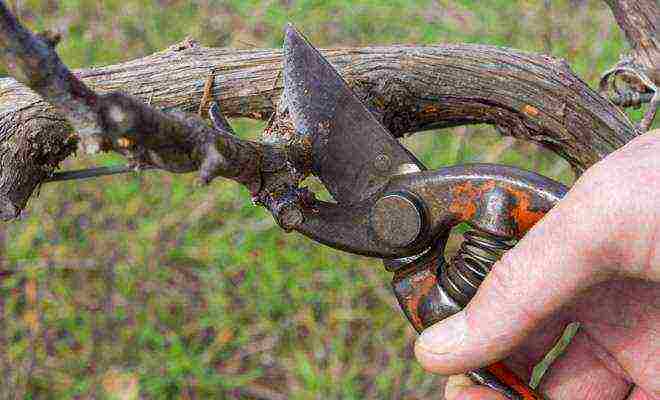
How to tie a bush correctly
Tying a grape bush is carried out in 2 stages:
- early spring;
- summer.
The first tying in the Samara region is carried out immediately after removing the shelter, until the buds have blossomed. The branches are bent to the bottom wire of the trellis and tied horizontally.
A summer green garter is made after the shoots have reached 50 centimeters in length. It is necessary so that the wind does not break the branches of the plant. The material for tying must be soft.
Scheme and timing of fertilization
First feeding carried out during the flowering period of the culture. Both organic and mineral fertilizers are used:
- nitrophoska - for 10 liters of water 50 g of the product per m2;
- presented solution and 0.4 g of boric acid.
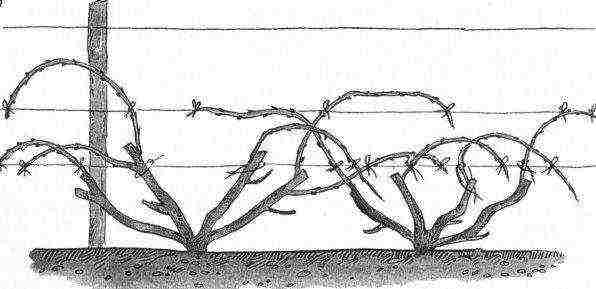
2 weeks after flowering, the time comes second feeding. Fertilizers are applied the same as for the first feeding.
Third feeding carried out during the formation of berries. To be applied per m2:
- 10 liters of water;
- 20 g superphosphate;
- 1 tbsp. l. potassium magnesium;
- 15 g of potassium salt.
Fourth feeding produced during the ripening of the berries. A mixture of 10 liters of water and 2 micronutrient tablets is introduced.
Final feeding carried out before winter. Potash fertilizers are applied.
Features of watering
Watering the grapes loves abundant, but infrequent. Given that the roots of the plant go deep into the ground, water should not be watered near the surface of the earth, but through a special irrigation pipe, which is dug in next to the trunk when planting. It should be remembered that excessive watering leads to cracking of the berries, and insufficient watering leads to wrinkling and peeling of the fruit.
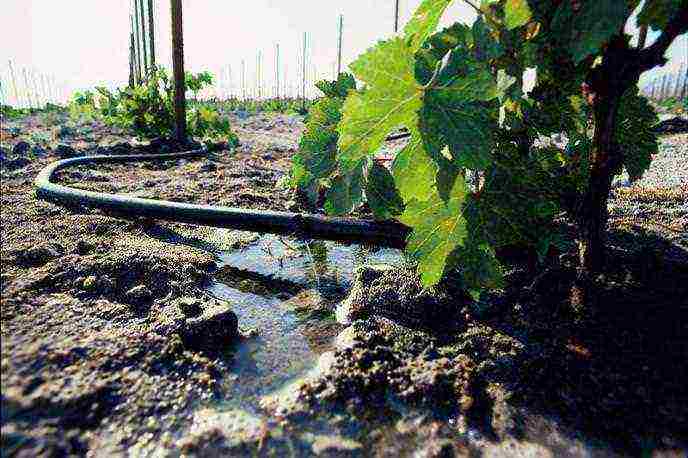
Protection from pests and diseases
The sweeter the grape variety, the more likely it is to be hit by wasps (Vesparum). To prevent insects from spoiling the berries, you need:
- destroy, if possible, all hornets' nests on the territory of the site;
- protect bunches of grapes with special mesh bags that are available on the market;
- spread a special protein bait for wasps in the area near the grapes.
For the first time they treat diseases shoots after they have reached 10 cm in length. 40 ml of "Abiga Peak" and 100 g of "Tiovit Jet" are dissolved in 10 liters of water.
Second processing carried out after 3 weeks. The same drugs are used to protect against anthracnose.
Third treatment grapes in the Samara region fall on the time before flowering. Take 10 l of water and 30 g of Cabrio Top strobilurin, as well as 4 g of Aktara. The presented mixture is enough for processing within 10 days. After that, the early varieties are not treated, unless only after harvesting with insecticides.
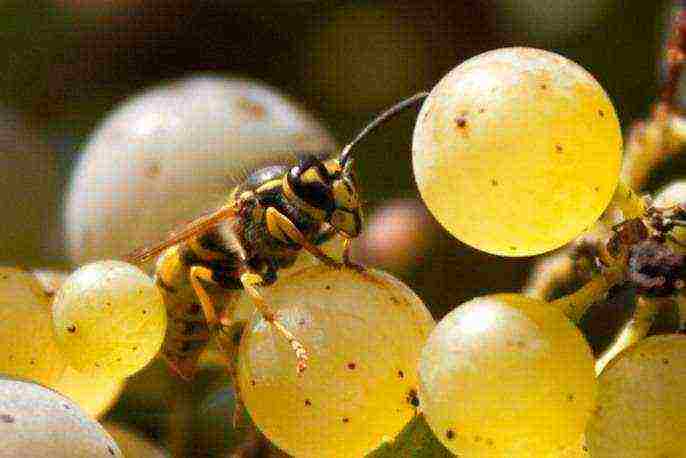
You may also be interested in an article in which we talk about how to properly prepare grapes for winter.
Shelter of grapes for the winter in the Samara region
Shelter for the winter of grapes is produced only after pruning the vine. If the bush is planted recently, then the shoots can be pressed to the ground and covered with sawdust or spruce branches on top. And in winter, with sufficient snow cover, make a snow mound on top, which will additionally protect the grapes from frost.
Large bushes are mulched in the trunk circle and also covered with snow.
How to plant grapes in spring (video)
Grapes are an unpretentious crop and with a little regular care you can achieve good results in its cultivation.
Reviews and comments
Did you find a mistake in the text? Please select it and press Ctrl + Enter. Thank you!
Rating:
(
estimates, average:
out of 5)
Peasant farm "Klimanov", better known in the Samara region as "Kinelsky grapes", carries out the cultivation and breeding of grapes on an industrial scale. It is the country's northernmost industrial vineyard. In the Kinelsky region, about 140 varieties are presented on a plantation of 6 hectares. Of these, about 30-40 varieties are recognized as the best for cultivation in garden plots.
Kinelsky grapes
Kinelsky grapes - the best varieties
Among the table varieties of this grape, about 10 of the best stand out. These are such varieties as Victor, Transfiguration, Libya, Jubilee of Novocherkassk, Millennium of Mordovia, Kodryanka, Arcadia. Of the technical varieties, this is Kinelsky-1. The largest variety is Transfiguration. The largest berries are in the varieties Victor, Yubiley Novocherkassk, Monarch.
Kinelsky grapes - the best varieties
Table. Brief characteristics of the best varieties.
|
Arcadia |
An old grape variety. Summer residents have already tested it. Large-fruited grapes. It tolerates cool, humid summers well. Weather resistant. This grape belongs to the table varieties. Ripens very early. Plants can be medium to above medium in height. They have dense clusters in the form of a conical cylinder, weighing 2 kg. Juicy fleshy berries of amber or white color ripen large (up to 15 g), with a heart shape. The peel of the berries is quite dense and tolerates transportation well. Produces a high yield. The variety is resistant to cold temperatures down to -21 ° C. |
|
Victor |
This is a hybrid variety. Ripens early or very early (3.5 months). It grows intensively. Gives large pink clusters weighing up to 1 kg with large long berries up to 20 g. The taste is sweet and juicy. |
|
Transformation |
Ripens early, over about 3.5 months. The bush develops rapidly, forming many stepchildren. The shape of the bunches is irregular or conical. The bunches reach 1.5 kg. The pink berries are long, large (up to 18 g), juicy and tasty. The skin is not very firm. It does not tolerate frost well, so it is imperative to cover it. |
|
Libya |
The ripening period is early (about 100 days). They have large clusters in the form of cylinders. The weight of the bunches can be up to 1 kg. The pink berries are egg-shaped and weigh 13 g. The taste is nutmeg, juicy and sweet. |
|
Anniversary of Novocherkassk |
Hybrid variety, ripens early (4 months). The bush grows quickly, the flowers are perfectly pollinated. Bunches in the form of a cone can weigh up to 1.7 kg. Large pink berries, elongated. The grapes are delicious, sweet and juicy. Produces a good harvest. High resistance to fungus. |
|
Codryanka |
The variety is especially resistant to diseases. Ripens early (about 100 days). Plants grow tall. Some bunches can reach 1.5 kg, and berries - 16 g. It is a dark variety with good taste. Produces a good harvest. |
|
Monarch |
Fruiting in late August. It is a hybrid variety. Large clusters with very large berries, up to 32 g. Berries are yellow with a reddish tint. They have a nutmeg aroma. The taste is pleasant. |
|
Millennium of Mordovia |
A new variety, bred in Novocherkassk. The variety ripens early enough. The bush grows tall. Produces large clusters with coarse pink berries with firm pulp. Tastes good. |
|
Kinelsky-1 |
Small clusters in the form of a conical cylinder. Reach almost 100 g by weight. The greenish berries are small, juicy, with firm skin. The taste is nutmeg. |
The choice of planting material
Care must be taken when choosing a supplier of seedlings. It is advisable to buy them from reputable grape farms. If the neighbor has good grapes, then he can share or sell the cutting. That is, it is advisable to see in advance the plant that you want to plant at home. You can find a seller at a trade show. You can also get advice on proper cultivation there.
Grape seedlings
On a note! The most important thing when growing grapes is to choose the right seedling.
The seedling should be with normal leaf plates and a height of at least 50 cm from the beginning of the root system to the top, so that it can be deepened to a depth of 50 cm.
How to choose grape seedlings
When to plant?
You need to plant grapes from May to October. All Kinelsk grapes have a closed root system. That is, you can get it out of the container, cut off the bottom of the container, and then plant the grapes to a depth of 50 cm so that the root system does not freeze.
Planting grapes
Step-by-step instructions for planting Kinel grapes
It is recommended to plant in a container, since the plastic serves as a heat shield, which reduces the risk of freezing of the root system. Moisture should always be present around the roots, so they put crushed expanded clay. Under the roots there is a litter layer of fertile soil, and even lower - expanded clay 10 cm. A hole can be dug or drilled with a 200 mm drill. This is enough and the plant is accepted.
Landing scheme
- First, you need to choose a seedling no longer than 0.5 m.
- Then dig a hole in the ground 0.6m wide and 0.7m deep.
- Cover the bottom with crushed expanded clay by 0.1 m, so that moisture is absorbed faster. Pour 0.1 m of soil mixture (sand, humus, soil, wood ash) on top.
- Plant a seedling on top and sprinkle it halfway with earth.
- During the summer, up to 4 sleeves (shoots) should appear on the plant.
- In the fall, it is necessary to fill up the soil to the very top of the hole.
- The sleeves should grow horizontally above the ground, not upward.
- It is necessary to ensure that the shoots grow parallel to the ground, so that later it is convenient to cover the grapes for the winter.
Video - Planting grapes
Two-plane trellis on the site
The figure shows a diagram of a two-plane trellis: 1 - polycarbonate roof; 2 - boards to which the reinforced film is attached; 3 - the wire on which we will tie the vine during the season; 4 - young vines that grow out of the buds during the season; 5 - overwintered sleeves with buds; 6 - trellis stands, supports for forming and tying a bush; 7 - fastening the plant to the wire on the trellis
Wasp control
Produced in the spring using the drug "Adamant". Wasps wake up from hibernation in spring. The uterus prepares to give birth to offspring, and the wasps fly and search for her food. A bait is made from pieces of meat, fish, mixed with the drug "Adamant", which is a poison that acts only on insects. It is of long duration. Wasps feed the uterus, she dies.
"Adamant"
Top dressing
Italian fertilizers from Valagro are recommended for Kinel grapes. Both root and foliar dressings are used so that the roots receive everything they need, the leaf has good photosynthesis, the vine ripens and you can get a cutting. Sleeves should be matured brown, with clusters and buds.Such a shoot is already ready for winter, it will make excellent seedlings.
Important! Grapes need potassium, magnesium and phosphorus. In this case, the fruits will be very beneficial for the human body.
Mineral fertilizer for grapes
The earliest feeding is when the buds burst. At this time, nitrogen is given (content - 30%).
In June, more phosphorus is added, which gives energy to flowering. Boron should also be given at this time (by the way, it should be given in May). In total, it is applied 3 times before flowering. This is to keep the pollen from getting dry. Otherwise, it does not pollinate plants, berries are not formed or are formed, but very small.
In the second half of the summer, you do not need to give nitrogen. It is necessary to include potash fertilizers in top dressing. This contributes to the fact that the wood itself becomes denser. Calcium is also used to aid in proper cell formation.
Potassium is increased in the autumn. Processing is carried out after harvest. To increase winter hardiness, boron, magnesium, calcium, manganese are introduced in the fall.
Grape
Grape seedlings care
After planting seedlings, it is especially important to properly care for the grapes. Regular procedures need to be done to get strong shoots. Care includes painstaking soil cultivation, proper watering, loosening and feeding, protection from diseases and pests, as well as covering plants for the winter.
Very handy vine mounts
Young plants in the first 12 months after planting are very demanding to care for. If everything is done correctly during this period, then in the future the Kinel grapes will delight with good harvests from year to year.
The main thing on which efforts should be directed is the formation of strong shoots. It is better to strive for the development of one viable and strong arm than to try to support the growth of several more frail branches. They may not be harvesting. It is also very important to prune the bushes. It is performed in the spring. At the same time, excess shoots are cut off and the root system is freed.
Removing stepchildren on grapes
Grape bushes do not require a lot of moisture when watering. It is necessary to stop the procedure at the moment when moisture ceases to be absorbed into the soil. Drying of the soil near the plants can be prevented by covering it with a layer of sawdust or film. It is advisable to add mineral fertilizers to the water for irrigation in summer. In this case, they should be selected taking into account the composition of the land. Acidic top dressing is chosen for introduction into alkaline soil. In this case, neutral fertilizers are also suitable.
Watering the grapes
Important! Another important event is the competent construction of a shelter for grapes in the cold season. This will help him survive the frosts, preserving the future high harvest.
Kinelsk grapes are quite cold resistant, but many varieties need winter shelter, which is not an easy procedure. First, the grapes are fertilized with minerals. It is produced in the last days of summer or at the very beginning of autumn. The composition of the fertilizer is selected based on the composition of the soil. Then, in the fall, the soil around the plants is loosened. After 2-3 weeks, it is necessary to water abundantly with water, filling the holes in width.
Growing Kinel grapes
When the air temperature begins to fall below zero, shelter is made. To do this, you need to do the following:
- dig a small ditch the width of the plants (its depth should be about 0.3 m);
- tie the sleeves with a rope and carefully put them in the ditch;
- pour soil on top (10 cm), then a layer of humus (10 cm) and cover with another layer of soil (10 cm).
An example of a grape shelter
The covering material covers the vine between the trellis posts. Very comfortably!
Video - Kinelsky grapes
We offer more than 100 of the best varieties of grape seedlings in 2018!
CATALOG OF GRAPE SEEDLINGS TABLE AND TECHNICAL VARIETIES
|
We offer seedlings own production the best varieties |
We deliver seedlings across the Russian Federation. When ordering from 10,000 rub. is free |
We are ready to transfer all my experience to you got the result |
We guarantee planting quality material |
You can always to get a consultation from our specialists |
Catalog
Add to cart
Augustine
RUB 300
Add to cart
novelty
Add to cart
Alice
800 RUB
Add to cart
stock
Add to cart
Anyuta
RUB 600
800 RUB
Add to cart
stock
Add to cart
Aramis
RUB 400
RUB 600
Add to cart
Add to cart
Arcadia
RUB 400
RUB 500
Add to cart
Add to cart
Bazhena
RUB 700
800 RUB
Add to cart
Add to cart
Baikonur
RUB 2,000
Add to cart
sale
Add to cart
Blagovest
RUB 500
800 RUB
Add to cart
Add to cart
Velika
800 RUB
Add to cart
sale
Add to cart
Viva Ayka
RUB 300
RUB 600
Add to cart
Add to cart
Victor
800 RUB
Add to cart
stock
Add to cart
Vodogray
650 RUB
800 RUB
Add to cart
Add to cart
Delight
RUB 300
Add to cart
Add to cart
Delight red / ZOS-1
RUB 200
RUB 300
Add to cart
recommend
Add to cart
Galahad
RUB 500
Add to cart
Add to cart
Gelius * / ARKADIA PINK
RUB 600
Add to cart
stock
Add to cart
Hermann
RUB 500
RUB 600
Add to cart
stock
Add to cart
Gourmet
RUB 400
RUB 600
Add to cart
novelty
Add to cart
Hussar
800 RUB
Add to cart
Add to cart
GF-41
RUB 350
Add to cart
Add to cart
Long awaited
800 RUB
Add to cart
recommend
Add to cart
Ermak
800 RUB
Add to cart
novelty
Add to cart
Pearl of Moldavia
RUB 500
Add to cart
recommend
Add to cart
Fun
800 RUB
Add to cart
Add to cart
Zarnitsa / Early Arcadia
RUB 700
Add to cart
Add to cart
Zarya Nesvetaya
800 RUB
Add to cart
novelty
Add to cart
Inga
RUB 400
Add to cart
stock
Add to cart
Kesha
RUB 300
RUB 400
Add to cart
recommend
Add to cart
Kseniya
800 RUB
Add to cart
stock
Add to cart
Lily of the valley
800 RUB
RUB 1,000
Add to cart
Add to cart
Lancelot
RUB 400
Add to cart
stock
Add to cart
Lelik
RUB 500
RUB 600
Add to cart
stock
Add to cart
Libya
RUB 600
800 RUB
Add to cart
Add to cart
Laura
RUB 400
RUB 500
Add to cart
Add to cart
Malvina
RUB 600
Add to cart
Add to cart
Master
RUB 500
RUB 700
Add to cart
Add to cart
Maestro
RUB 500
RUB 700
Add to cart
Add to cart
Nadezhda AZOS
RUB 500
Add to cart
Add to cart
Nadezhda Aksayskaya
RUB 400
Add to cart
Add to cart
Lowland
RUB 500
RUB 600
Add to cart
Add to cart
Ovation
RUB 500
Add to cart
Add to cart
In memory of Lazarevsky
RUB 500
800 RUB
Add to cart
Add to cart
In memory of Negrul
RUB 600
Add to cart
Add to cart
In memory of the surgeon
RUB 600
Add to cart
Add to cart
Transformation
800 RUB
Add to cart
Add to cart
Producer
RUB 500
Add to cart
Add to cart
Prometheus
800 RUB
Add to cart
Add to cart
Rochefort
RUB 600
Add to cart
recommend
Add to cart
Ruta
RUB 600
800 RUB
Add to cart
sale
Add to cart
Senator
RUB 500
800 RUB
Add to cart
novelty
Add to cart
Sun drops
800 RUB
Add to cart
Add to cart
Strashensky / Consul
RUB 300
Add to cart
Add to cart
Super Extra (new name CITRIN)
RUB 500
RUB 600
Add to cart
Add to cart
Tomaysky
RUB 300
Add to cart
stock
Add to cart
Favor
RUB 500
800 RUB
Add to cart
Add to cart
Pharaoh
RUB 600
Add to cart
Add to cart
Buffet
RUB 500
Add to cart
Add to cart
Khutorok
RUB 600
Add to cart
Add to cart
Elegant
RUB 400
Add to cart
sale
Add to cart
Anniversary 50
RUB 400
RUB 500
Add to cart
Not available
Anniversary of Novocherkassk
800 RUB
Not available
Add to cart
Julian
800 RUB
RUB 1,000
Add to cart
Add to cart
Jaguar
800 RUB
Add to cart
recommend
Add to cart
Radiant
RUB 600
Add to cart
Add to cart
Sofia
800 RUB
Add to cart
Add to cart
Ainset Sidlis
RUB 500
Add to cart
Add to cart
Kinelsky-1
420 RUB
Add to cart
recommend
Add to cart
Livadia black
RUB 400
Add to cart
Add to cart
UNIVERSAL
35 RUB
Add to cart
Not available
Spring 1 (complex fertilizer), 100 g
RUB 100
Not available
Add to cart
Spring 2 (complex fertilizer), 100 g
RUB 100
Add to cart
Add to cart
Boron (fertilizer), 100 g
RUB 150
Add to cart
Add to cart
Summer 1 (complex fertilizer), 100 g
RUB 100
Add to cart
Add to cart
Summer 2 (complex fertilizer), 100 g
RUB 100
Add to cart
Add to cart
Autumn 1 (complex fertilizer), 100 g
RUB 100
Add to cart
novelty
Add to cart
Arpolit, a new generation natural soil improver (Germany), 1 kg
RUB 1,450
Add to cart
Add to cart
Flexible garter for plants, 5 m
RUB 80
Add to cart
Add to cart
Osmocote (Osmokot) Exact Standart | 15-9-12 + 2MgO + ME 5-6M, 100 g, manual packing
RUB 100
Add to cart
novelty
Add to cart
Osmocote (Osmokot) Exact Hi-End | 15-9-12 + 2MgO + ME 5-6M, 100 g, manual packing
RUB 100
Add to cart
novelty
Add to cart
Osmocote (Osmokot) Exact Standart High К | 11-11-18 + ME 5-6M, 100 g, manual packing
RUB 100
Add to cart
novelty
Add to cart
Osmocote (Osmokot) Pro | 17-11-10 + 2MgO + ME 5-6M, 100 g, manual packing
RUB 100
Add to cart
Not available
OTOS drug, 10 g
RUB 25
Not available
Add to cart
Topaz (from oidium)
RUB 45
Add to cart
Not available
Profit Gold, 1.5 g (from mildew)
42 RUB
Not available
Not available
MAXIM SUMMER (from rot)
RUB 45
Not available
Not available
Tiovit Jet, 15 g (from oidium)
42 RUB
Not available
Add to cart
Fufanon-Nova, 2 ml
RUB 23
Add to cart
Add to cart
Ridomil Gold, VDG 20 g (from mildew)
120 RUB
Add to cart
product of the month
Add to cart
Non-woven covering material for grapes, 1 meter (100 cm)
RUB 100
Add to cart
Video
 November. Covering grapes is easy!
November. Covering grapes is easy! 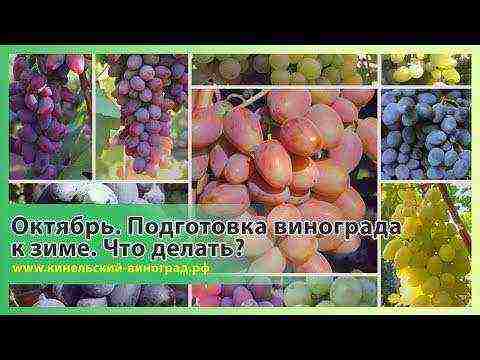 October. Preparing grapes for winter. What to do?
October. Preparing grapes for winter. What to do? 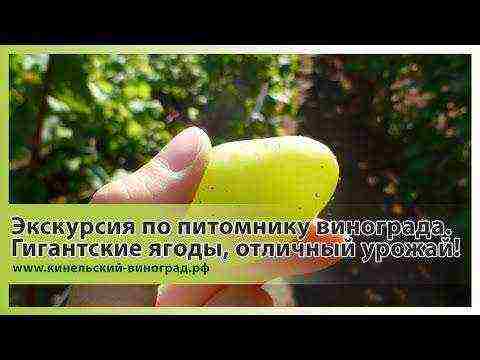 Tour of the grape nursery. Giant berries, great harvest
Tour of the grape nursery. Giant berries, great harvest  How will we cover the grapes? Cooking covering material in the fall
How will we cover the grapes? Cooking covering material in the fall  Grapes in August 2017. Express tour of the nursery
Grapes in August 2017. Express tour of the nursery  What if the grape seedlings planted this year are not growing?
What if the grape seedlings planted this year are not growing?
subscribe to news
News Green operations on grapes in July. Nothing extra!
30.07.2018
Friends, we have prepared two videos for you that will help you decide on the work in the vineyard during this period.
First, what green operations need to be performed now. We remove excess leaves, shoots and stepsons. Recall that it is better to do this in the morning or in the evening, so that the berries that open to the sun do not have burns.
Midsummer - how can we support the grapes?
09.07.2018
Good afternoon friends! The second half of July is coming - the peak of summer in Central Russia. The grapes bloomed and began to form berries. It's time to change the diet and that's what we need for a complete diet of our plants.
Early July. What do we treat to grapes?
03.07.2018
Have a nice day and great weather! If you missed our last video on the Kinelsky grapes YouTube channel, we will briefly tell you about what should be done with grapes now and what works are coming up in the near future.
First, do not forget to loosen the grapes. Let's remind the old wisdom - one loosening replaces three waterings. In addition, loosening and removing weeds protects the grapes from various diseases and infestations of parasites.
The grapes are in bloom. How to feed him?
27.06.2018
Today we have prepared useful information for you that will help you make your work with grapes as efficient as possible. Recall that now is the time to feed the grapes with Leto1 and Bor fertilizers.
Fertilizer Leto1 contains algae extract, Boron, Zinc, Manganese, Potassium. We do the processing on a sheet at a dosage of 2 g per liter of water. This dressing stimulates the formation of ovaries and increases the yield of the grapes. If the grapes in your area are prone to peas, Leto1 will allow you to remove this deficiency.
Grape dressing scheme
13.06.2018
Friends! Today we have prepared a scheme for feeding grapes, which, we hope, will not leave any ambiguities - what, when and how much to apply. The scheme is suitable primarily for our colleagues who have purchased complex fertilizers Vesna1, Vesna2, Bor, Leto1, Leto2 and Autumn. If you use other fertilizers, the schematic representation of fertilizing will tell you at what stage of grape development, what nutrition the grapes need most.
Delivery of seedlings to Samara on June 8, 2018
05.06.2018
Colleagues! On Friday, June 8, another delivery of seedlings to Samara. An excellent opportunity to place an order right now (better by phone, because we have not included something in the catalog on the site). In addition, we will visit CDEK and the Post Office. If you need delivery to another city, we will send it, you will receive it next week.
Fertilizers for grapes. June. Instructions for use
05.06.2018
Have a nice June day, friends!
It seems that summer has returned to our region and it's time to pay serious attention to feeding the grapes. Because of the “cold” pause, it just didn't make sense for a while. At low temperatures (as well as at very high temperatures), plant nutrition is not absorbed. Now is the time to give the grapes, as one of our customers puts it, feeding. What we will do in the near future.
Let's check our songs
01.06.2018
As we planned to complete the delivery by June, it happened! There are still two deliveries in Samara - No. 1027, 1020 and additional delivery of fertilizers and covering material. Below is information on orders where we are in arrears. If you see your number, it means that in the near future you will receive everything that we owe you. If we have not marked someone, immediately report it - we are ordinary people, we may miss something, but we are ready to quickly correct our mistakes.
And again about the delivery
23.05.2018
Colleagues! We are glad to announce that long-distance delivery is almost complete and now all efforts will be thrown into local delivery - in Samara and its adjacent districts.
Thanks to everyone who patiently waited for their seedlings and everyone who took the time to write to us and thank us for the work done. We tried our best!
We complete long distance delivery and proceed to delivery across Samara!
18.05.2018
Friends! We managed to ship most of our long distance orders this week! If your order has not arrived yet, then it is either on the way, or is about to go on the road. Today we ship orders under the following numbers: 1192, 1024, 1165, 1129, 1132, 1176, 1163, 1180, 1183, 1189, 1130, 1023, 1071, 1041, 1056, 978. And very little will remain!
Big request - show patience! We try to do our best to ensure that you receive your parcels as quickly as possible. At the same time, you need to be vigilant so as not to confuse cities, orders and all that. Let us remind you that our seedlings have a closed root system and you can plant them all season, so a couple of days will not make the weather for you, and we, again, will try to make delivery as soon as possible. Yes, and by the way, at the moment orders for grape seedlings are not accepted or processed. We took this step only because we want to speed up all delivery processes. But you can still come to the nursery and buy seedlings on the spot. Have a good day!
Articles Seedlings for the Fazenda exhibition (Moscow, April 24-28, 2018)
20.03.2018
List, number and description of varieties for the Fazenda exhibition here.
Read more How to plant grapes
01.02.2015
Planting our seedlings is very easy. The most troublesome thing is to prepare the landing pit according to the indicated scheme. Let's be honest, it's pretty hard work. If you are preparing a hole with a garden shovel, then it will take at least a couple of hours: digging, rested, and back to work.
Read more
Reviews
Asset 1
Good afternoon! Acquired several saplings of table grape varieties in the spring. Excellent planting material! Development is going well, they are growing and pleasing to the eye! But I do not intend to dwell on this)). I will expand my vineyard and buy not only table varieties, but also technical ones. And I strongly advise you all!
Irina July 25, 2017, 09:44
Good evening! This is the first time I come across such attention. Usually they send the material, and then at least the grass will not grow.Thank you for your trouble! I took the seedlings, I'll plant them tomorrow. The material is great - just a miracle. Thank you!
Alexander July 21, 2017, 18:12
Good day everyone! As an ordinary ordinary buyer of your grapes, I can confirm that all the varieties I bought, and I have eight of them, fully correspond to the descriptions in the catalog. In my opinion, this is the main and, in fact, the most important criterion for assessing the performance of your work, to offer exactly what is being sold in reality, without deception. When buying a seedling, you cannot define anything, in fact, it is a "pig in a poke", and you can make sure that you are not deceived no earlier than in the 2nd year of planting. I recommend without advertising and toadying! I'm happy with everyone! I will not talk about the private, you will take everything on the site, as I once did.
Elena Vladimirovna Kozhina, order No. 688 March 3, 2017, 11:42 am
Today I received from you the book “The Healthiest Drink on Earth. Dry red wine". A very interesting book, I learned a lot of useful things from it. I recommend to buy, who does not have it, you will not regret it !!!
Sergey January 24, 2017, 13:06
According to the results of the drawing, which took place on December 6, I won the book "The Healthiest Drink on Earth". I have already received the parcel. The book contains a lot of useful and interesting information about grapes and red wine. Thanks a lot!
Yulia Viktorovna December 19, 2016, 15:32
Hello! I wanted to thank you once again for the great pleasure our grapes bring us. We bought it from you 2 years ago, came to you in Kinel for seedlings. This is just a miracle! All neighbors in the country come to look at our harvest. I treat you with joy, and you have enough yourself! We have already bought the Monarch, Pretty Woman, Codryanka from you. We plan to make more purchases this year. Thank you very much! We will definitely come to one of your exhibitions in the summer in order to buy berries as well. We love your Timur, Aramis, Rochefort, Libya very much. Probably, we will buy some of these varieties for our collection.
<Growing grapes in the Middle Volga region is becoming a popular activity for gardeners. The region has all the main factors that contribute to this, namely, a relatively sufficient amount of heat (the duration of the frost-free period is 135-160 days), a significant intensity of insolation. Snow cover is formed mainly in November. Low air humidity does not allow the development of diseases such as mildew (the most dangerous fungal disease of grapes) and rot. An outbreak of these diseases is possible only in certain wet years and with an unfavorable agricultural background (in the case of thickened plantings, etc.).
All these factors were taken into account when laying the collection vineyard of the Samara Zonal Experimental Fruit and Berry Station in the 1930s.
It is known that local viticulture becomes successful only when it is based on those varieties that have been tested for a long time in local conditions, during which they have demonstrated high consumer characteristics. The work of the experimental station for the selection of grapes was aimed at breeding and transferring to the GSI varieties with a yield of at least 100 c / ha, with high taste qualities, with an early ripening period of berries, as well as with frost resistance and resistance to gray rot, mildew, oidium.
The work on the selection and zoning of grapes in the Samara region, carried out in the 30-80s of the last century by scientists P.G. Merkulova, V.G. -Volzhsky region. Suffice it to say that the collection of the vineyard consisted of 4000 plants, representing at least 300 varieties, and an industrial plantation of 4 hectares was created. During this period, the selection of new grape varieties was actively and successfully, combining high consumer characteristics of berries and also increased frost and drought resistance necessary for the zone of risky gardening.Such varieties as Malengr early, Madeleine Angevin, Muscat Hungarian, Muscat Hamburg, Amur, Yellow Yezandari, Shasla white, pink and nutmeg, Portugizer, Buytur, etc. were used as parent grapes.
The result of the research was the creation of high-quality table and universal grape varieties included in the State Register, some are still successfully grown in garden plots not only in the Samara region, but also in some neighboring regions. These are such varieties as Kuibyshevsky, Kuibyshevsky early, Pervenets Kuibysheva, Kuibyshevsky early ripening. In the same period, work was carried out on the selection of frost-resistant rootstocks for grapes and the Buitur variety was selected. Annually, up to 70,000 units of planting material grown on the basis of the Institute were sent to the farms of the Samara, Ulyanovsk, Penza, Orenburg and Saratov regions and the Mordovian Autonomous Soviet Socialist Republic, as well as to amateur gardeners.
At the All-Russian exhibitions and fairs, grape varieties of local selection have repeatedly won awards and prizes.
In the 90s, research on grape breeding was suspended. The work on the selection and varietal study of grapes in the Samara region has been resumed since 2006 after the creation of the Research Institute of Horticulture and Medicinal Plants "Zhigulevskiye Sady".
Currently, more than 40 varieties of local selection and introduced from other institutes are under study at the collection site of grapes. Most of them are very early and early maturing. Local varieties: Kuibyshevsky early, Zhuravlik, Muscat Kuibyshevsky, Rusich, Volzhsky Utyos, Amethyst Samarsky, Kuibyshevsky, Nectar of the Volga region, Yantar Samarsky, Corundum, Palmira, Krasa Volga region, Muscat Merkulova, Volzhsky violet.
Introduced varieties: Alpha, Kesha, Agat Donskoy, Nadezhda AZOS, Tukay, Rusbol, Kodryanka, Victoria, Lydia, Black Delight, Laura, Cosmonaut, Summer Muscat, Cardinal, Chernysh, Platonovsky, Mirage, Memory of Negrulya, Frumoas Albe, Druzhba, Pleven , Radiant, Pearl Saba, Timur, Sasha.
From the surviving hybrid fund, varieties were selected, which, after many years of variety study, were transferred to the state variety testing. All studied local varieties confirmed the previously achieved characteristics and demonstrated their stability.
As for the comparative assessment of local and introduced varieties, the following can be said. The unfavorable climatic conditions of 2009-2010 affected all studied varieties, despite the fact that some of the introduced varieties, according to catalogs, have a slightly higher frost resistance (-23 ... -25 ° С) than most local varieties (-20 ... -22 ° WITH). Moreover, a comparison of the indicators of winter hardiness of the eyes showed that local varieties recovered faster from the harsh conditions of December 2009 and the extreme summer of 2010.
The yield of the grape varieties bred by the Institute was higher than the yield of the introduced grapes.
With regard to resistance to fungal diseases, the local varieties turned out to be somewhat less resistant to mildew than the introduced ones, but more resistant to powdery mildew and gray rot. In general, local varieties showed more stable characteristics than most introduced ones.
According to the results of many years of study, for cultivation in the Samara region, in addition to local grape varieties, it is possible to recommend introduced ones, namely Muscat Letniy, Agat Donskoy, Kodryanka and Rusbol.
